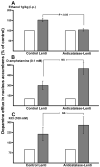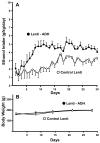Ethanol as a prodrug: brain metabolism of ethanol mediates its reinforcing effects
- PMID: 21332529
- PMCID: PMC3142559
- DOI: 10.1111/j.1530-0277.2011.01439.x
Ethanol as a prodrug: brain metabolism of ethanol mediates its reinforcing effects
Abstract
Background: While the molecular entity responsible for the rewarding effects of virtually all drugs of abuse is known, that for ethanol remains uncertain. Some lines of evidence suggest that the rewarding effects of alcohol are mediated not by ethanol per se but by acetaldehyde generated by catalase in the brain. However, the lack of specific inhibitors of catalase has not allowed strong conclusions to be drawn about its role on the rewarding properties of ethanol. The present studies determined the effect on voluntary alcohol consumption of two gene vectors, one designed to inhibit catalase synthesis and one designed to synthesize alcohol dehydrogenase (ADH), to respectively inhibit or increase brain acetaldehyde synthesis.
Methods: The lentiviral vectors, which incorporate the genes they carry into the cell genome, were (i) one encoding a shRNA anticatalase synthesis and (ii) one encoding alcohol dehydrogenase (rADH1). These were stereotaxically microinjected into the brain ventral tegmental area (VTA) of Wistar-derived rats bred for generations for their high alcohol preference (UChB), which were allowed access to an ethanol solution and water.
Results: Microinjection into the VTA of the lentiviral vector encoding the anticatalase shRNA virtually abolished (-94% p < 0.001) the voluntary consumption of alcohol by the rats. Conversely, injection into the VTA of the lentiviral vector coding for ADH greatly stimulated (2 to 3 fold p < 0.001) their voluntary ethanol consumption.
Conclusions: The study strongly suggests that to generate reward and reinforcement, ethanol must be metabolized into acetaldehyde in the brain. Data suggest novel targets for interventions aimed at reducing chronic alcohol intake.
Copyright © 2011 by the Research Society on Alcoholism.
Figures




Comment in
-
Ethanol as a prodrug: brain metabolism of ethanol mediates its reinforcing effects--a commentary.Alcohol Clin Exp Res. 2011 Apr;35(4):581-3. doi: 10.1111/j.1530-0277.2011.01454.x. Epub 2011 Feb 25. Alcohol Clin Exp Res. 2011. PMID: 21352247
References
-
- Amit Z, Brown ZW, Rockman GE. Possible involvement of acetaldehyde, norepinephrine and their tetrahydroisoquinoline derivatives in the regulation of ethanol self-administration. Drug Alcohol Depend. 1977;2:495–500. - PubMed
-
- Aragon CM, Amit Z. The effect of 3-amino-1,2,4-triazole on voluntary ethanol consumption: evidence for brain catalase involvement in the mechanism of action. Neuropharmacol. 1992;31:709–712. - PubMed
-
- Aragon CM, Rogan F, Amit Z. Ethanol metabolism in rat brain homogenates by a catalase-H2O2 system. Biochem Pharmacol. 1992;44:93–98. - PubMed
-
- Cohen G, Sinet PM, Heikkila R. Ethanol oxidation by rat brain in vivo. Alcohol Clin Exp Res. 1980;4:366–370. - PubMed
Publication types
MeSH terms
Substances
Grants and funding
LinkOut - more resources
Full Text Sources
Other Literature Sources
Medical

